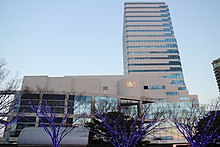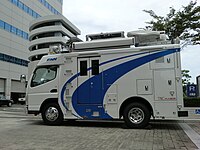Television Nishinippon Corporation
 | |
 | |
Trade name | Television Nishinippon Corporation |
|---|---|
Native name | 株式会社テレビ西日本 |
Romanized name | Kabushikigaisha Terebinishinihon |
| Company type | Kabushiki gaisha |
| Industry | Television broadcasting |
| Founded | April 1, 1958; 66 years ago (1958-04-01) |
| |
|---|---|
| City | Fukuoka |
| Channels |
|
| Branding | Television Nishinippon |
| Programming | |
| Affiliations | Fuji News Network and Fuji Network System |
| Ownership | |
| Owner | Television Nishinippon Corporation |
| History | |
| Founded | 1 April 1958 |
First air date | 28 August 1958 |
Last air date | 24 July 2011 (JOHX-TV) |
Former channel number(s) | 9 (analog VHF, 1962–2011) JOHX-TV: 10 (analog VHF, 1958–2011) |
Former affiliations | NNN/NNS (1958–1964) |
| Technical information | |
Licensing authority | MIC |
| Links | |
| Website | www.tnc.co.jp/ |
Television Nishinippon Corporation (株式会社テレビ西日本, Kabushiki Gaisha Terebi Nishinippon, TNC) is a Japanese TV station affiliated with Fuji News Network (FNN) and Fuji Network System (FNS) in Fukuoka. This station serves Fukuoka Prefecture and also acts as the default FNN affiliate for western portions of Yamaguchi Prefecture including Yamaguchi City and Shimonoseki, as Yamaguchi Prefecture does not have an FNN affiliate of its own.
History
In 1957, the Ministry of Posts and Telecommunications announced the first TV channel plan. In Fukuoka Prefecture, operators such as "Nishinippon Television" funded by Nishinippon Shimbun and "Kyushu Asahi Broadcasting" funded by Asahi Shimbun applied for a TV broadcasting license.[1]: 29 On October 22, 1957, Nishiippon Television received a preliminary license conditionally on the premise of "merging with Kyushu Asahi Broadcasting as much as possible". Therefore, Nishinippon TV's investment ratio at that time was 70% for Nishinippon Shimbun and 30% for Asahi Shimbun.[1]: 30–31 At the second founder meeting held on January 7, 1958, Nishinippon TV decided to build a signal transmitting station in Sarakura Mountain, Yawata City.[1]: 31 On April 1 of the same year, Nishinippon Television officially registered and established a company.[1]: 31 Since one of Tokyo's two flagship stations, Radio Tokyo Television, had a network relationship with RKB Mainichi Broadcasting in Fukuoka Prefecture at that time, Nishinippon TV management decided to air Nippon Television programming instead.
In 1959, TNC established a labor union.[1]: 109 On March 18, 1961, due to the breakdown of wage negotiations between labor and management, the TNC union launched a week-long strike.[1]: 39 In March of the following year, TNC also experienced a large-scale strike when its labor union occupied a signal transmitting station, resulting in West Nippon Television suspending broadcasts from March 24 to April 7.[1]: 39
Since Fukuoka Prefecture was divided into two broadcasting areas, Kitakyushu and Fukuoka, TNC obtained the broadcasting license for the Kitakyushu area (Kyushu Asahi Broadcasting obtained the Fukuoka area broadcasting license), so TNC initially only transmitted signals in the Kitakyushu area.[1]: 36 In the summer of 1960, both TNC and KBC stated that they had no intention of merging with each other.[1]: 112 At the same time, TNC began to try to include the Fukuoka area into the broadcasting area, and obtained the consent of the Postal Ministry and Kyushu Asahi Broadcasting.[1]: 36 Afterwards, TNC purchased land in Kamitakamiya Town, Fukuoka City, to build its Fukuoka headquarters, which was completed in 1962.[1]: 39 On February 14 of the same year, TNC began broadcasting its signals in the Fukuoka area.[1]: 39
JOHX-TV was originally established as an affiliate of Nippon News Network (NNN) and Nippon Television Network System (NNS) in Yahata (Yahata Higashi-ku, Kitakyūshū) in August 1958, airing on VHF channel 9; a station in Fukuoka was established in February 1962 as JOJY-TV. They changed affiliation from NNN and NNS to FNN and FNS in October 1964 - changing their national programming to that of Fuji Television. The head office was moved to Fukuoka, and the call sign changed from "JOHX-TV" (still the call sign of Kitakyūshū satellite station (airing on VHF channel 10)) to "JOJY-TV" in December 1974. They relocated their office to its current location near Fukuoka Tower in August 1996. During the station's first 53 years of broadcasting, JOHX-TV's analog signal was receivable over-the-air in most of Yamaguchi Prefecture.
On July 20, 1966, TNC broadcast its first color program, Jungle Taitei, the first color anime. In April of the following year, 34% of its prime time programs were in color.[1]: 78 In April 1970, all of TNC's prime time programs were in color, and 76.8% of all-day programs were in color.[1]: 79 In 1967, TNC's turnover reached 2.2 billion yen, and its profit reached 400 million yen.[1]: 350 On April 30, 1971, the small plane in which Koga Masaaki, an employee of West Nippon Television, crashed while collecting news, and Koga Masaaki died in the line of duty.[1]: 172
In the first week of January 1973, West Nippon Television won the prime-time ratings championship for the first time with a ratings of 19.4%.[1]: 178 The following year, while West Nippon Television carried out a large-scale expansion of its Fukuoka headquarters, it also moved the company's registration headquarters and main control room and other important facilities from Yawata City to Fukuoka City.[1]: 44–47 On November 13 of the same year, West Nippon Television began transmitting signals from Takamiya's headquarters.[1]: 47 West Nippon Television introduced the electronic news gathering (ENG) system in 1979, which greatly improved the efficiency of news gathering and editing.[1]: 80 The following year, TNC began to implement the two-day weekend system.[1]: 206 In 1981, West Japan Television introduced corporate identity and launched a new logo.[1]: 210 In the same year, TNC signed a sister station agreement with KGMB-TV in Hawaii, becoming its first overseas sister station.[1]: 211 In 1982, TNC began broadcasting stereo TV programs.[1]: 215 TNC signed a sister station agreement with China's Dalian Television in 1986, the second such agreement.[1]: 233 In 1987, TNC's turnover exceeded 10 billion yen for the first time.[1]: 351 In 1989, TNC introduced the Satellite News Broadcasting (SNG) system.[1]: 81–82 In the same year, TNC won the triple crown of ratings for the first time with average ratings of 9.2% for the whole day, 16.4% for prime time, and 16% for evening time.[1]: 353 From then until 1996, West Nippon TV won the triple crown of ratings for eight consecutive years [4]: 353. In 2003, West Nippon TV won the triple crown of ratings again after 7 years.[1]: 353
TNC also further strengthened international cooperation at the turn of the century. In 1999, West Japan Television and South Korea's PSB Busan Broadcasting signed a cooperation agreement.[1]: 297 In 2002, it signed a sister station agreement with France 3.[1]: 310 In the same year, West Japan Broadcasting also co-produced a program[1]: 311 with South Korea's PSB Busan Broadcasting. In 2004, West Japan Broadcasting, Dalian TV and Busan Broadcasting held a director's meeting and issued a joint declaration to strengthen cooperation. Since then, the three TV stations have jointly produced programs many times.[1]: 321
Digital broadcasts on JOJY-TV began on 1 July 2006, and the analog signal continued to broadcast until 24 July 2011, when JOHX-TV (which served northern portions of Fukuoka Prefecture and western portions of Yamaguchi Prefecture) ceased operations.
TV channel
Main station
- Fukuoka 34ch(Digital) 9ch(Analog)
Tandem offices

- Kitakyūshū 29ch(D) 10ch(A:JOHX-TV)
- Kurume 29ch(D) 60ch(A)
- Minami Ōmuta 29ch(D) 56ch(A)
- Ōmuta 29ch(D) 55ch(A)
- Yukuhashi 34ch(D) 54ch(A)
- Itoshima 34ch(D)
- Munakata 29ch(D)
Programs
- Momochihama Store (ももち浜ストア)
- Hachinabi Plus Super News (ハチナビプラス スーパーニュース)
- Tobe Tobe Hawks (とべとべホークス, Tobe tobe Hōkusu)
- Saturday News File CUBE (土曜ニュースファイルCUBE, Doyō nyūsufairu kyūbu)
- Hanamaru Daikichi no "Nan shiyōto?" (華丸・大吉のなんしようと?, lit; Hanamaru-Daikichi's "What're you doing?")
- BASEBALL SPECIAL Fukuoka SoftBank Hawks Live
- Cow Television
- Riding Uphill ガチ★星
Other TV stations in Fukuoka
- NHK Fukuoka and Kitakyushu
- Kyushu Asahi Broadcasting (KBC, 九州朝日放送, affiliated with TV Asahi and ANN) - 1
- RKB Mainichi Broadcasting (RKB, RKB毎日放送, affiliated with TBS TV, Inc. and JNN) - 4
- Fukuoka Broadcasting Corporation (FBS, 福岡放送, affiliated with NTV and NNN / NNS) - 5
- TVQ Kyushu Broadcasting (TVQ, TVQ九州放送, affiliated with TV Tokyo and TX Network) - 7
References
- ^ a b c d e f g h i j k l m n o p q r s t u v w x y z aa ab ac ad ae af ag テレビ西日本50年史編纂室. 『テレビ西日本開局50年史 : おっ!?テレ西』. 福岡縣: テレビ西日本 [TV West Japan 50-year history: Oh!? Telenishi]. Television Nishinippon Corporation. 1984.
External links
- Official website of TV Nishinippon
- v
- t
- e
- TNC TV Nishinippon
- STS Saga TV
- KTN TV Nagasaki
- TKU TV Kumamoto
- TOS TV Oita 1
- UMK TV Miyazaki 1, 2
- KTS Kagoshima TV
- OTV Okinawa TV
- BS Fuji
  | This article about a television station in Japan is a stub. You can help Wikipedia by expanding it. |
- v
- t
- e
 | This article about a Japanese corporation- or company-related topic is a stub. You can help Wikipedia by expanding it. |
- v
- t
- e









